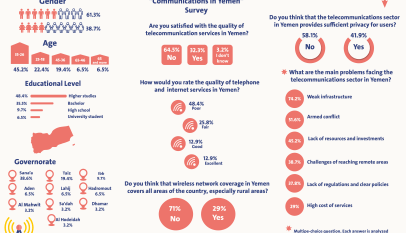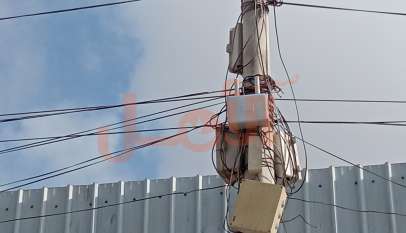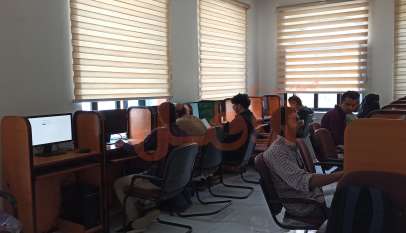The Consequences of the Conflict on the Telecommunications Sector Threaten the Lifeline
Sawt Al-Amal (Voice of Hope) – Hebah Mohammed
Amidst the ongoing conflict in Yemen for years, the telecommunications sector faces a serious crisis that threatens to sever the only lifeline for communication and development for millions of Yemenis. Telecommunications is considered a vital sector in the country, which has suffered catastrophic damages and significant financial losses over the past nine years. According to a report by the Ministry of Communications and Information Technology, the cost of damages and financial losses incurred by the telecommunications and postal sector during the conflict in Yemen until March 2020 amounted to approximately $4.1 billion.
In this report, we shed light on the consequences of the conflict on the telecommunications sector in Yemen and how the communication infrastructure and services have been affected, with a focus on the damages and challenges faced by the country in this regard. The telecommunications sector in Yemen faces an uncertain future, as the continuation of the conflict threatens its complete collapse.
Infrastructure of the Telecommunications Sector
Since the beginning of the conflict, the telecommunications infrastructure in Yemen has suffered significant damages. Stations, optical towers, and cables have been targeted, leading to service disruptions and a decline in their quality. These ongoing attacks have caused damage to the telecommunications infrastructure, resulting in weakened and interrupted communication services in several areas of the country.
Yemen Dynamic Needs Assessment (DNA): Phase 3 in 2020, issued by the World Bank, indicated that approximately 25% of the assets used in the telecommunications sector in Yemen have been partially damaged or destroyed since the start of the conflict in 2015. The estimation of damages is likely to be lower than the actual figures due to the difficulty of assessing them accurately, given the ongoing security disturbances in most areas.
The international assessment also mentioned that the provinces of Al-Hodeidah and Saadah have been the most affected by damages in the telecommunications and information technology sector compared to other provinces, which also suffer from disruptions and conflicts. The destruction rate in those provinces exceeded 75% of the assets of the mobile phone network.
According to the assessment, the main reasons for these losses and damages are the lack of fuel, recurring power outages, institutional divisions, different financial demands from both Sana’a and Aden, asset seizures, and extortion practiced by some parties involved in the conflict. This led to one of the telecommunications companies declaring bankruptcy earlier in 2020, only to resume operations using 4G technology from Aden Governorate.
Employees in the telecommunications company believe that private telecommunications companies providing mobile phone services have incurred financial losses due to the scarcity of petroleum derivatives needed to operate their generators and equipment in the main center and branches, including infrastructure, receivers, and equipment. Additionally, they need fuel to operate transmission stations in various areas due to the constant public electricity outages.
During the period between January and March 2020, Yemen experienced a major Internet service disruption due to the main submarine cable passing through the Suez Canal being cut. This led to paralysis in commercial transactions, internal and external financial transfers, jobs, and official work across Yemen.
According to IT specialists, one of the challenges facing the telecommunications sector in conflict-affected Yemen is the interference of political roles in the organizational and operational processes within the sector, especially regarding communication and Internet services. This has created absolute monopolies in the Internet market at the national level, leading to significantly inflated prices compared to other countries in the region and the world. In addition to the difficulty of accessing maintenance teams belonging to the telecommunications sector in several provinces and directorates to repair Internet cables, communication towers, and networks that may be deteriorated due to the ongoing conflict in those areas, resulting in a weakened service.
Initial Material Losses
The Ministry of Communications and Information Technology in Sana’a revealed in 2023 the initial financial losses incurred by the telecommunications sector, its companies, and the postal service due to the ongoing conflict. The losses amounted to more than $10.925 billion, equivalent to over YER 6.55 trillion.
The ministry’s statement indicated the complete destruction of approximately 706 facilities, while around 400 civil facilities were damaged. The conflict also led to the suspension of services in more than 862 facilities and post offices, resulting in the isolation of over 114 Yemeni villages and cities from the world. The conflict also resulted in the closure of airports, seaports, and land ports to postal services, with no letters reaching Yemen since 2016.
The CEO of the Public Telecommunications Corporation, Eng. Sadiq Mosleh, stated that the institution’s losses amounted to $2 billion. The catastrophic effects on civil society were reflected in the inability to access telecommunications and Internet services, depriving over 1.271 million individuals of these services in many Yemeni governorates.
Amr Wahan, the CEO of the Yemen Postal Authority, also mentioned that the authority suffered direct damage to 27 postal facilities, with 20 facilities experiencing significant and partial damage, leading to losses of over $609.757 million.
Dr. Ali Naji Nosary, the CEO of Yemeni International Telecommunications Company (TeleYemen), discussed the losses incurred by the company, including the destruction of the international Internet gateway building in Al-Hodeidah Governorate due to the impact of the conflict on the province. The company’s building in Sana’a was also targeted and completely destroyed.
TeleYemen, operating since 1996 through a single provider (Yemeni International Telecommunications Company), owns the digital gateway for international communications and the Internet in Yemen. It connects to the international network through terrestrial and submarine cables, linking Yemen to four terrestrial routes and three submarine routes as part of the “Digital Belt” project to connect Yemen regionally and internationally.
Due to the ongoing conflict in Yemen, the country now relies on only three routes, including the Al-Wadea port in Hadhramout province, Al-Ghaydah port connected to the international submarine cable “Falcon,” which supplies Yemen with the majority of its international Internet capacity, and the third route, Aden port, connected to two fiber optic cables. The number of Internet users in Yemen reached over 7.2 million users by the end of 2019, compared to around 3.2 million users in 2014. Essam Al-Hamli, the Chairman of the Board of Directors of Yemen Mobile Company, stated that the company rehabilitated 98 sites, with 40 sites being rehabilitated for the second time.
The total losses of the company during the years of conflict amounted to $1,681,421,000, while the company continued to provide services by transitioning to the fourth generation (4G) and expanding the central equipment of control centers and units.
Limited Internet Services
Yemen suffers from a limited international Internet capacity, reaching only 130 gigabytes, which is a very small percentage compared to the size of the Internet in other countries worldwide. The current state of Internet service in Yemen has caused significant problems for its users, making access to the network complex and an ongoing struggle.
According to a report issued by the Washington Institute in March 2022, Yemen tops the list of countries with the lowest rankings in global communications. This means that low bandwidth availability, high latency, and the cost of Internet connectivity in Yemen are among the highest in the world.
Due to the lack of Internet exchange points and local data centers in Yemen, the report explains that Internet traffic needs to be routed almost entirely through international systems. This means that Yemenis accessing websites like YouTube retrieve data from servers in the United States instead of local servers, resulting in a significant slowdown in connection speed.
As a result, relying on routing Internet traffic through the international network puts additional strain on the limited international bandwidth, which is less than one-tenth of the global average per individual. All of this has contributed to a decline in fixed Internet speed in Yemen, reaching one of the lowest levels globally, with an average speed of 2.76 megabits per second and a global ranking of 178, according to speed test applications.
Some economic reports suggest that despite the challenges faced by the telecommunications sector in Yemen, telecommunications companies have managed to compensate for some of their losses by providing various services to maintain their consumer base. There is also ongoing work to develop the regulatory and institutional framework of the sector in line with modern international standards in the field of information technology and to encourage competition in the local market.
74.2% of Respondents in the Survey See the Lack of Infrastructure as One of the Most Prominent Problems Facing the Telecommunications Sector in Yemen
Sawt Al-Amal (Voice of Hope) – Yomna Ahmed The telecommunications sector is one of the mo…












